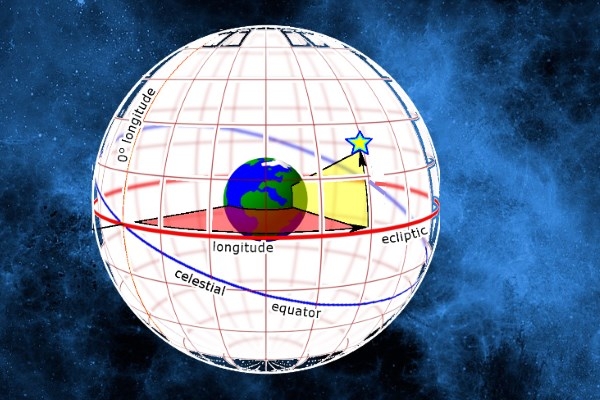Primary Directions are an ancient technique for forecasting. It is based on the primary motion of the earth – its 360 degrees of motion over the course of one day. As the earth turns, each of the planets rise, culminate and set. John Savarese provides a summary of his books that explain the technique and the steps for calculation.
A Summary of Directed Angles and Primary Directions by John Savarese, B.A. Syracuse University 1972, M.A. City University of New York, Hunter College 1974, NCGR-PAA (National Council for Geocosmic Research Professional Astrologers’ Alliance) Level 3.
From the birthtime of a birth or event, each of the four angles in a chart (Asc, MC, Desc and IC) is “directed” to each planet in the chart as time ticks forward from the LST of the chart. An angle is directed to a planet (on that planet in the chart) at a particular sidereal time, for example when the Asc is directed to Mercury at a particular sidereal time, Mercury is said to be rising on the Asc at that sidereal time. If the MC is directed to Jupiter at a sidereal time, Jupiter is said to be culminating at the MC at that sidereal time. If the IC is directed to Saturn at a sidereal time, Saturn is said to be anti-culminating at that sidereal time. If the Desc is directed to Venus at a sidereal time, Venus is said to be setting at that sidereal time.
This can be seen in what is known as a “speculum”, which shows the four columns of the four angles and the rows of the planets to the left of the columns. Each “cell” in the speculum “table” contains the sidereal time at which the angle of a column is directed to the planet of a row. The speculum is a “snapshot” taken at the birthtime that shows the sidereal times at which each angle is directed to each planet. Also, if Mercury is rising at the Asc at a sidereal time and Venus is setting at the Desc at the same or close sidereal time, these two planets are in an “in mundo” (in the world) opposition to each other. A speculum sorted in a list of sidereal times shows all the in mundo conjunctions, oppositions and squares between planets that are rising, culminating, setting and anti-culminating at close or equal sidereal times. The directed MC and IC sidereal times of a planet are extracted from the right ascension of the planet, and the directed Asc and Desc sidereal times of the planet are calculated from the right ascension and declination of the planet.
Directed angles become primary directions when they are used to specify the dates on which the planets are most influential in a person’s lifetime. Each planet in the person’s chart is more or less near an angle. In a clockwise direction in the chart, the angle that is just ahead of a planet will become the first angle directed, and the powerful influence of that planet to which that angle is directed will occur first in the person’s life. The next closest planet to an angle which will be directed to that planet will be the next powerful influence in the person’s life, and so on for all the remaining planets. We can calculate not only the ages of the person at which these influences occur but also the actual
days on which these influences occur (five examples are provided in the books mentioned below).
So we have still another astrological technique in our proverbial astrological toolkits. The concepts and applications of Primary Directions will not only enhance your knowledge of Astrology but will enable your clients to know when the effect of each planet is most prominent in their lifetimes. You don’t have to be a “siderealist” to understand these events, which are thoroughly explained in my two books:
Western Sidereal Astrology for Beginners and The Most Intense Days. The methodology employed to derive primaries from directing angles to planets can be used in tropical, conventional astrology. Experiment with the calculations to see what works best for you. Challenge your mind. The clear and concise concepts and calculations are easy to learn and fun to use. Simple instructions on how to use the readily available Casio fx-260 Solar calculator in each example are also provided. Both books are available in large softcover format or as e-books for the total price of $22.95 at www.myprimaries.com which contains links to Amazon.



